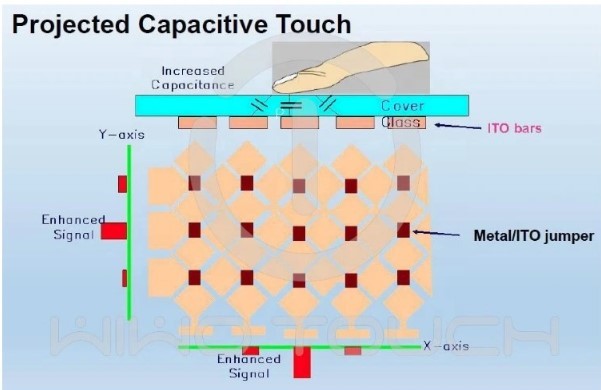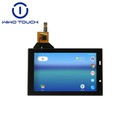Capacitive screen in principle the human body as a capacitor element of an electrode to use, when touching the capacitive screen, the human body electric field, finger and conductor layer will form a coupling (ǒu) between the capacitance, four electrodes issued by the electric current will flow to the contact, and its strength is proportional to the distance between the finger and the electrode, is located in the controller behind the screen of the touch screen will be calculated the proportion of the electric current and the strength of the touch point of the location of the accurate calculation.
Simply put: capacitive touch screen is a transparent layer of special metal conductive material affixed to the glass surface. When the finger touches on the metal layer, the capacitance of the contact will change, making the oscillator connected to the frequency changes, through the measurement of frequency changes can determine the touch location to obtain information.
Capacitive touch sensors are ideally suited to applications that require environmental sealing against dust, dirt and grease. For example, the surfaces of kitchen appliances are often soiled with food and dust, which can quickly damage electromechanical switches. Capacitive touch sensors are not only immune to such damage, but can be easily wiped down to provide a more hygienic interface.
This ability to seal the sensor also benefits industrial equipment expected to be used in explosive environments. Ordinary electromechanical switches produce sparks on contact, the size of which depends on the voltage and current used. If such switches are not properly sealed, they can ignite an explosive environment. Since capacitive touch sensors can be completely sealed, their risk of explosion is virtually nil.
Another potential application for capacitive touch sensors is devices that require many mechanical cycles. While electromechanical switches can have millions of mechanical life cycles, certain applications require more, such as payment terminals at public transport stations. Due to the lack of mechanical components, capacitive touch sensors are virtually immune to long-term mechanical damage.
Finally, capacitive touch sensors are ideal for self-checkout screens, especially since such surfaces can be easily cleaned without damaging the capacitive touch sensor. This has become increasingly important since the start of the COVID-19 pandemic, coupled with advances in technology that allow for antimicrobial treatments to be applied to glass surfaces, effectively preventing the growth of bacteria. This has led to touchscreens being used in a wide range of public facilities.





